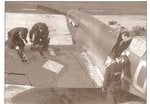mpapadakis
Airman
Although this is related to a modelling project, I would like to ask whether any one of you out there could contribute with more in depth information about this aircraft (other than what is available on the internet)
I am very much interested in building a model of the Mk I - AF 106 that was alegedly sent to Boscome Down for flight trials. Anything related to this story would be very much help.
Thank you all very much in advance
Here you can see the model after it has been converted to represent the British variant.

I am very much interested in building a model of the Mk I - AF 106 that was alegedly sent to Boscome Down for flight trials. Anything related to this story would be very much help.
Thank you all very much in advance
Here you can see the model after it has been converted to represent the British variant.





